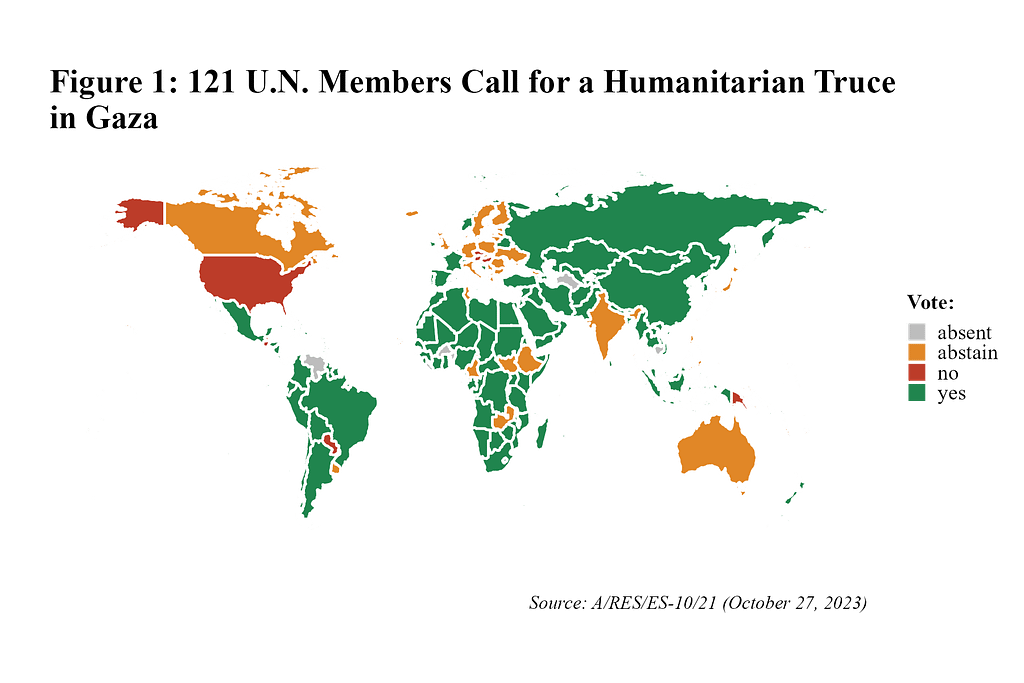As outlined in the UN General Assembly’s Rules of Procedure, it convenes in three distinct formats: regular sessions, special sessions, and emergency special sessions (ESS). The inception of the ESS dates to the adoption of Resolution 377A(V) by the General Assembly on November 3, 1950, during the Korean crisis. Since its establishment, the General Assembly has conducted a total of 11 ESSs. Notably, unlike the initial nine ESSs, the last two sessions remain ongoing. The tenth ESS addressing the Israeli-Palestinian conflict commenced in April 1997, while the eleventh ESS was triggered by Russia’s invasion of Ukraine on February 24, 2023.
This post examines the most recent resolutions adopted by the tenth ESS. These resolutions followed Israel’s invasion of Gaza, which occurred after Hamas attacked Israel on October 7, 2023.
Although the General Assembly’s resolutions are not legally binding, they carry moral weight. They are also a good tool to measure UN members’ opinions of global events. As noted above, ESS-10 has been intermittently convening since April 1997. It has adopted 22 resolutions on many issues related to “Illegal Israeli actions in occupied East Jerusalem and the rest of the Occupied Palestinian Territory”. One noteworthy resolution is A/ES-10/18, adopted shortly after Israel invaded Gaza in 2008. It called on Israel and Hamas to comply with UN Security Council Resolution 1860, which urged the parties to cease hostilities and address the population’s humanitarian needs. This resolution also called on Israel to withdraw its troops from Gaza.
ESS-10 was reconvened after the United States (US) vetoed a Brazilian-sponsored resolution in the Security Council called for a “humanitarian pause” in Gazan on October 17, 2023. Frustrated by the Security Council’s inability to address the crisis, the members of the UN’s Arab Group and countries affiliated with the Organization for Islamic Cooperation asked for the resumption of the ESS. After two days of debate, members voted on A/ES-10/21.

The resolution, needing a two-thirds majority, was approved with 121 votes in favor and 14 against. Fourteen members did not vote and 44 abstained. Noteworthy were the abstentions from key European allies of the US, along with Japan, Australia, and Canada. In discussions before and after the vote, some delegates from these countries advocated for a “humanitarian pause” while emphasizing their preference for a text that strongly condemned Hamas and its actions on October 7, 2023.
On December 8, 2023, the US once again vetoed a short draft resolution in the UN Security Council, demanding a humanitarian ceasefire in Gaza. As a result, Arab states decided to reconvene the tenth ESS once again to further pressure Israel to cease its military activities. Four days later and after a short debate, the General Assembly adopted A/RES/ES-10/22, garnering 153 votes in favor, while 10 states opposed it, and 23 abstained from voting. Notably, seven countries chose not to participate in these deliberations.

While the prior A/RES/ES-10/21 called for a “‘humanitarian truce,” the latest resolution escalated the tone, demanding an “immediate humanitarian ceasefire.” Notably, A/RES/ES-10/22 did not include references to Hamas or a condemnation of its October 7 attack on Israel. Although these omissions sparked intense debates in late October, many governments, while still advocating for a stronger stance against Hamas, believed that the situation on the ground and Israeli actions necessitated an “‘immediate humanitarian ceasefire.”
This adoption of this resolution will not immediately lead to the conclusion of hostilities in Gaza. Its passage reflects growing global dissatisfaction with Israeli policies. This development not only intensifies Israel’s diplomatic isolation within the UN. It also raises significant questions about the Biden administration’s dedication to fostering peace in Gaza and its commitment to a two-state solution.
A Note on the Data and Maps
These choropleth maps were created in R, using the ggplot2 package. To learn how to make similar maps, check my tutorial on this website.
The voting outcomes data used to generate these maps can be found in the World Politics Data Lab’s GitHub depository.
